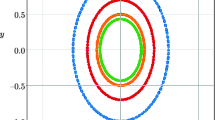Summary
A system ofN harmonic oscillators having a quadratic nonlinear coupling was numerically analysed. Solutions of the nonlinear problem are decomposed in terms of the normal modes of the linear system. A number of initial conditions were considered. We computed the energy in a mode as a function of time and the corresponding average energy. We found that, when initially all the energy of the mode system was in the lowest-frequency mode and the oscillators were at rest, the final time-averaged energy distribution showed that, as we increased the number of oscillators, the first fewlow odd modes received more energy on the average than neighboring even modes. When the energy was initially equipartitioned among the modes and the oscillators were initially at rest, we found that the time-averaged energy distribution of approximately the firstN/4 modes fell off monotonically with increasing frequency, with the other 3N/4 modes keeping essentially all of their energy. Finally, when the energy was initially distributed in a «Planck-like» distribution, the final time-averaged energy distribution was also a «Planck-like» distribution which was quite similar to the initial distribution. In fact, there was very little energy sharing among the modes in this case. When the space-time variation of the actual string was analysed, we found that the «Planck-like» distribution with the oscillators initially at rest was, at least to a good approximation, a «normal mode» of the nonlinear system.
Riassunto
Si è analizzato numericamente un sistema diN oscillatori armonici con un accoppiamento non lineare quadratico. Si sono scomposte le soluzioni del problema non lineare attraverso i modi normali del sistema lineare. Si è considerato un certo numero di condizioni iniziali. Si è calcolata l’energia in un modo in funzione del tempo e la corrispondente energia media. Si è trovato che quando inizialmente tutta l’energia relativa al sistema di modi si trova nel modo di frequenza inferiore e gli oscillatori sono in quiete, la distribuzione finale dell’energia in valore medio rispetto al tempo rivela che, aumentando il numero degli oscillatori, ai primissimi modi dispariinferiori spetta in media più energia che ai vicini modi pari. Dividendo inizialmente in parti uguali l’energia fra i vari modi e ponendo gli oscillatori in quiete, si è trovato che la media temporale della distribuzione dell’energia dei primiN/4 modi circa diminuisce monotonamente all’aumentare della frequenza, mentre gli altri 3N/4 modi mantengono tutta la loro energia. Infine si è notato che distribuendo inizialmente l’energia secondo una distribuzione del tipo di Planck, la media temporale della distribuzione finale dell’energia segue pure una distribuzione del tipo di Planck, che è molto simile a quella iniziale. Infatti in questo caso c'è una piccolissima ridistribuzione dell’energia fra i modi. Dopo aver analizzato la variazione spazio-temporale della corda effettiva, si è trovato che la distribuzione del tipo di Planck con gli oscillatori inizialmente in quiete è, almeno con buona approssimazione, un «modo normale» del sistema non lineare.
Резюме
Численно анализируется системаN гармонических осцилляторов, имеющих квадратичную нелинейную связь. Рещения нелинейной проблемы представляются в виде нормальных мод линейной системы. Рассматривается ряд начальных условий. Мы вычисляем энергию в моде, как функцию времени, и соответствующую среднюю энергиу. Мы получаем, что если первоначально вся энергия системы мод была в низщей частотной моде и осцилляторы покоились, то конечное усредненное по времени энергетическое распределение показывает, что при увеличении числа осцилляторов первые нескольконцжних нечетных мод получают больще энергии в среднем, чем окружающие четные моды. Когда энергия была распределена первоначально равномерно между модами и осцплляторы первоначально покоились, то мы получаем, что усредненное по времени энергетическое распределение для приблизительно первыхN/4 мод спадает монотонно с увеличением частоты, а остальные 3N/4 моды содержат, в основном, всю энергию. Когда же энергия первоначально распределена, согласно распределению планковского типа, то конечное усредненное по времени энергетическое распределение также является планковского типа, которое очень похоже на первоначальное. В этом случае происходит незначительное перераспределение энергии между модами. Когда анализируется пространственно-временное изменение реальной струны, то мы получаем, что распределение планковского типа с первоначально покоящимися осцилляторами представляет, по крайней мере, хорошее приближение для «нормальной моды» нелинейной системы.
Similar content being viewed by others
References
E. Fermi, J. Pasta andS. Ulam:E. Fermi Collected Papers, edited byE. Amaldi,et al. (Chicago, Ill., 1965), p. 978.
J. Ford:Journ. Math. Phys.,2, 387 (1961).
J. Ford andJ. Waters:Journ. Math. Phys.,4, 1293 (1963).
P. Bocchieri, A. Scotti, B. Bearzi andA. Loinger:Phys. Rev. A,2, 2013 (1970).
L. Galgani andA. Scotti:Phys. Rev. Lett.,28, 1173 (1972).
H. Hirroka andJ. Saito:Journ. Phys. Japan,25, 23 (1967).
N. Ooyama, H. Hirooka andN. Saito:Journ. Phys. Japan,27, 815 (1969).
R. L. Bivins, N. Metropolis andJ. R. Pasta:Nonlinear coupled oscillators: model equation approach, Los Alamos Report LA-4934 (1972)
F. M. Izrailev, A. I. Khisamutdinov andB. V. Chirikov: LA Report 4440 TR.
J. L. Tuck andM. T. Menzel:Adv. Math.,9, 399 (1972).
J. B. Scarborough:Numerical Mathematical Analysis, II Ed. (Oxford, 1950), p. 244, 265.
K. S. Kunz:Numerical Analysis (New York, N. Y., 1957), p. 209.
R. H. Miller:Journ. Comp. Phys.,8, 449, 464 (1971).
A. I. Khinchin:Mathematical Foundations of Statistical Mechanics (New York, N. Y., 1949).
G. E. O. Giacagia:Perturbation Methods in Nonlinear Systems, Chap. IV and V (Berlin, 1972).
V. I. Arnol’d:Math. Surveys,18, 85 (1963).
A. N. Kalmogorov:Dokl. Akad. Nauk SSSR,98, 527 (1955).
J. Moser:Siam Rev.,8, 145 (1966).
Author information
Authors and Affiliations
Additional information
To speed up publication, the author of this paper has agreed to not receive the proofs for correction.
Work supported in part by the United States Atomic Energy Commission.
Traduzione a cura della Redazione.
Перебедено редакцией.
Rights and permissions
About this article
Cite this article
Wallace, J. Planck distribution in a classical nonlinear coupled harmonic-oscillator system. Nuov Cim B 22, 22–42 (1974). https://doi.org/10.1007/BF02737457
Received:
Revised:
Published:
Issue Date:
DOI: https://doi.org/10.1007/BF02737457




